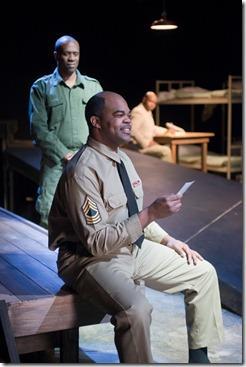
A Soldier’s Play
Written by Charles Fuller
Directed by Michael Menendian
at Raven Theatre, 6157 N. Clark (map)
thru March 30 | tickets: $15-$36 | more info
Check for half-price tickets
Read entire review
Historical and historic play a great showcase for its young actors

Raven Theatre presents
A Soldier’s Play
Review by John Olson
It’s Academy Award season, and it may be coincidental that Raven has opened this play in the same week as the Oscar telecast. Its 1984 film adaptation was nominated for Best Picture (which it lost to “Amadeus”) and two other awards. The original 1981 off-Broadway production ran over a year and featured Denzel Washington and Samuel Jackson early in their careers. The Pulitzer Prize winning play is not performed much these days, it seems, but Michael Menendian’s production at Raven makes a case that it ought to be more than a footnote in the entertainment history books. It concerns the difficulties the U.S. Army had in integrating African-American soldiers into their World War II fighting units and digs even deeper than that into a pivotal moment in the history of American race relations.

Another reason for seeing the play is the chance to enjoy the fine performances of its young cast. Pierre Antoine Whitfield plays Sergeant Waters with a frightening ferocity. We see why the late sergeant is unlikely to be mourned. Frank Pete as the investigator Capt. Davenport is a steely, non-nonsense officer, in complete control the whole time, yet understanding and resenting his very limited ability to change the conditions under which black men served in the military at that time. The enlisted men are given insufficient individual lines and scenes to become fully fleshed out characters, but the actors involved – Tamarus Harvell, Bradford Stevens, Brian Keys, Carthy Dixon, Rashawn Thompson, Eric Walker and Kory Pullam work quickly to draw distinct characters with traits that range from angry and defiant to easy-going and innocent. Collectively, they give a convincing portrait of young men filled with energy & passion who find themselves in the new & perplexing position of dealing with racism in a new and strange way. On opening night, the cast seemed to rush through the first act, but they settled down in the second act, as I suspect they will for the full play as they get farther into the run.
Andrei Onegin’s set is effectively simple and suggestive of the barracks and officer’s offices. Its sparseness is entirely appropriate for the flashback scenes in which Davenport’s interviewees recount their versions of the events leading up to Waters’ death. The production also boasts a soulful original score by Leif Olsen and moody, mysterious lighting by Diane D. Fairchild.
Just as the original off-Broadway production introduced the likes of Denzel Washington and Samuel L. Jackson to the theatre-going public, Raven’s production showcases some fine actors we hope to see more frequently on Chicago stages.
Rating: ★★★
A Soldier’s Play continues through March 30th at Raven Theatre, 6157 N. Clark (map), with performances Thursdays-Saturdays at 7:30pm, Sundays 3pm. Tickets are $15-$36, and are available by phone (773-338-2177) or online through TicketTurtle.com (check for half-price tickets at Goldstar.com). More information at RavenTheatre.com. (Running time: 2 hours, includes an intermission)

Photos by Dean LaPrairie
artists
cast
Tamarus Harvell (Corporal Bernard Cobb), Scott Allen Luke (Captain Wilcox), Bradford Stevens (Private James Wilke), Nicholas Bailey (Lieutenant Byrd), Antoine Pierre Whitfield (Tech Sergeant Vernon C. Waters), Brian Keys (Private C.J. Memphis), Carthy Dixon (Corporal Ellis), Rashawn Thompson (Private Louis Henson), Tim Walsh (Captain Charles Taylor), Frank Pete (Captain Richard Davenport), Eric Walker (Private First Class Melvin Peterson), Kory Pullam (Private Tony Smalls)
behind the scenes
Michael Menendian (director); Cathy Darrow (stage manager); Conor Clark (asst. director, asst. stage manager, understudy); Diane D. Fairchild (lighting design); Marie C. Quinn (sound design); JoAnn Montemurro (costume design); Mary O’Dowd (props, set dressing); Amanda Rozmiarek (scenic artist); Andrei Onegin (set design, tech director); Adrian Rozendaal, Mike Bettenhausen (assistant to the technical director); Justin Castellano (master electrician); Leif Olsen (original score), Kristen Williams (dramaturg); Kelly Rickert (graphic design, videography); Luke Millett (videographer), David Woolley (fight choreography), Trish George (production assistant), Dean LaPrairie (photos)
13-0236

